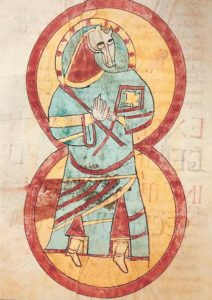Bridwell ms 35
See for description of Bridwell MS 35:
http://www.smu.edu/bridwell/specialcollections/bridwellwesternms/ms35.htm
Christopher De Hamel in his description of The Bible of Wouter Grauwert, in Latin, 1443-45, refers to MS 35 as below:
\”The mixing of Old and New Testaments is quite unexpected at any period of biblical history, known to us as occurring only, although differently, in the so-called ‘Biblia Irregularis’ of the early thirteenth century [almost certain before 1230], now MS 35 in the Bridwell Library at Southern Methodist University, Dallas.\”
In his description of the smaller illuminated initials in the Wouter Bible, he states that \”In addition [to the 13 large historiated initials], there are many large initials which show animals and creatures which are not illustrative of the text as such but are certainly pictorial, such as a jester emerging from a flower and playing two pipes, a wing dragon with a human head, a young woman with the hind legs of a dog …\” The BI is certainly filled with animals and creatures not illustrative of the text.
Christopher De Hamel looked at the manuscript when he lectured at Bridwell on his last visit and his comment after looking at it for some time, was that he had examined over 3,000 ms., and that he had never seen anything like it, probably not produced in France, evidently written/copied before 1230, and maybe even before 1220.
Several other renowned medieval scholars, including Dr. Larry Ness, are as puzzled about the text as Dr. De Hamel.
I have been worked on the manuscript for the last 5 years and am almost convinced that the BI is of an Alcuin exemplar of the late 10th cent., as many of the variants are from Consensus codicum secundum exemplar Alcuini scriptoriam; Legionessis, Leon, S. Isidoro, codex gothicus. 960 in Hispinia; Toletanus, Madrid, Bibl. Nac, Vitr. 13-1 (Tol. 2-1, s.x. in Hispinia).
Also, the Confessio Esdras, IV Ezra (II Esdras) chapter 8, v. 20-36, is included as a separate text following the end of Nehemiah, which appeared as a separate text for first time in the Codex Legionesis, ca. 960. Which later became a Christian confession of faith! The Gospels follow the Confessio as the last 4 books. The MS in not the result of faulty rebinding as each book follows the previous book on the same folio. The following inscription is of a perplexed 17th century reader: \”the scribe originally copied them, for reasons yet to be determined, in this strange order.\” Ownership inscription of the Celestines of Sens, 1681.
And, that the animal/beast images seen in the Eastern textiles hanging in the cathedrals served as the model for the 8 historiated and the 63 floriate initials with animal/beast, beads heads and birds, similar to Gautier Lebaube atelier (i.e., in Branner), smaller initials in red and blue within red and blue with complementary pen work extensions throughout. Illustrations include an Ass playing a harp, an Ass on his hind legs with bells in both front feet, a rabbit playing a harp, only 3 human type figures with weapons (sword, club with shield, and drawn bow), etc. Why else would they be seen in a 12th-13th century bible, with the mingling of the books, void of any Jewish/Christian symbols.
Any suggestions would be appreciated. I can send samples of text and images if interested. I am currently working on a power-point presentation.
Page A. Thomas
Retired, Special Collection
Birdwell Library
Southern Methodist University
Nouveaux liens ~ New Links
Enguerrand Quarton Online : site de Virginie Clève consacré à l’enlumineur du XVe s. et à sa production [En ligne]
Enluminures.info : Virtual Museum of Illuminated Manuscripts [En ligne]
LIBER Manuscript Librarians Group : Third International Conference
The LIBER Manuscript Librarians Group recognises the unique significance of manuscript and archive collections, not only for the world of research and learning, but also for a wider audience of people interested in history and cultural heritage…
The Third Manuscript Librarians Conference will be held at the Staatsbibliothek zu Berlin, Germany – 28-30 November 2007.
Le Manuscript Librarians Group est né en 2001 sous la tutelle de la Ligue Européenne des Bibliothèques de Recherche.
Sa troisième conférence aura lieu les 28/30 novembre 2007 à Berlin.
Site du Manuscript Librarians Group [En ligne]
Site de LIBER [En ligne]
Program [En ligne]
La table de Peutinger ~ The Tabula Peutingeriana
Drawn in 1265 by a monk of Colmar and made up of 11 parchments scrolls about 34 cm high each and 6,74 m. long altogether assembled, this document was discovered in 1494 by Konrad Meissel alias Celtes and given in 1507 to an Antiquarian of Augsburg, Konrad Peutinger…
At present the Tabula Peutingeriana is conserved at the Austrian National Library (Österreichische Nationalbibliothek) and, with the authorization of this institution, Christos Nüssli is able to present on line the 11 original segments of this Roman roadmap.

(c) Euratlas/ Christos Nüssli

La Bretagne: Condate/Rennes – Fanomartis/Corseul – Vorgium/Carhaix -Gesocribate/Brest – Reginea/Erquy ?
Réalisé en 1265 par un moine de Colmar et constitué de 11 parchemins hauts d’environ 34 cm qui, bout à bout, totalisent une longueur de 6,74 m., ce document a été découvert en 1494 par Conrad Meissel alias Celtes et remis en 1507 à un antiquaire d’Augsbourg, Conrad Peutinger.
Actuellement la Table de Peutinger est conservée auprès de la Bibliothèque nationale autrichienne (Österreichische Nationalbibliothek) et c’est avec l’autorisation de cette institution que Christos Nüssli est en mesure de présenter en ligne les 11 segments originaux de cette carte routière de l’Antiquité.
Source: Christos Nüssli / Euratlas [En ligne]
Pages
Auteur du blog : Jean-Luc DEUFFIC

Commentaires recents
- dans Le livre d’heures et de raison de Maximilien Turpin, conseiller à la Gouvernance de Lille ( † 1704)
- dans Un ami nous a quitté: Gwenaël Le Duc (12 octobre 1951- 24 décembre 2006)
- dans René de Chasteaubriant (+ ca 1500), chevalier pèlerin pour la Terre Sainte, comte de Guazava au royaume de Fez
- dans René de Chasteaubriant (+ ca 1500), chevalier pèlerin pour la Terre Sainte, comte de Guazava au royaume de Fez
- dans Le «Maître du Policratique de Charles V» : un enlumineur breton ?
Visites depuis 10/03/2020
- 173
- 0
- 706



